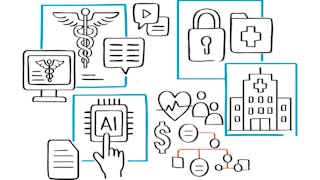Improving health and healthcare institutions requires understanding of data and creation of interventions at the many levels at which health IT interact and affect the institution. These levels range from the external “world” in which the institution operates down to the specific technologies. Data scientists find that, when they aim at implementing their models in practice, it is the “socio” components that are both novel to them and mission critical to success. At the end of this course, students will be able to make a quick assessment of a health informatics problem—or a proposed solution—and to determine what is missing and what more needs to be learned.


The Social and Technical Context of Health Informatics
This course is part of Health Informatics Specialization

Instructor: Harold P. Lehmann, MD, Ph.D.
46,400 already enrolled
Included with
(578 reviews)
Recommended experience
What you'll learn
Articulate a coherent problem definition of, and a plan for addressing, a healthcare informatics problem.
Create an Informatics Stack analysis of an informatics problem.
Describe eleven socio-technical aspects of a health informatics problem or solution.
Skills you'll gain
- Informatics
- Healthcare Industry Knowledge
- Interoperability
- Health Information Management
- Health Information Management and Medical Records
- Electronic Medical Record
- Health Policy
- Data Literacy
- Health Systems
- Emerging Technologies
- Health Care Procedure and Regulation
- Health Technology
- Technology Strategies
- System Requirements
- Health Care
- Medical Imaging
- Health Informatics
Details to know

Add to your LinkedIn profile
See how employees at top companies are mastering in-demand skills

Build your subject-matter expertise
- Learn new concepts from industry experts
- Gain a foundational understanding of a subject or tool
- Develop job-relevant skills with hands-on projects
- Earn a shareable career certificate

There are 4 modules in this course
In this module, you will be given an introduction to the course and its foundational concepts. After providing examples of health IT in the contexts of patients, providers, and populations—the three contexts we always return to—we articulate the drivers that motivate developments in health IT and informatics. We then provide the core definitions of key terms (like “health IT” and “informatics”) and introduce the core framework for your work in this course, the Informatics Stack.
What's included
11 videos1 reading1 assignment
In this module, we start our journey down the Stack to explain the world of informatics and health IT. We explore the top four levels of the Stack (World, Organization, Roles, and Functions), and then proceed to discuss new US medical-care (“World”) policies that drive health care Organizations to change practice, so they can accomplish their core Functions. We also discuss the history of health IT in relation to such policies in the past. We begin a course-long discussion of interoperability (which occurs at each level of the Stack), and privacy/confidentiality/security. We end with an explication of methods used to Evaluate whether an IT project has achieved the Organizational goals set for that project.
What's included
6 videos1 assignment
In this module, we continue the journey, starting with the role of needs, requirements, and specifications. We then turn to how workflow issues are turned into requirements and how information systems, built to satisfy those requirements, are assembled. We close with the cautionary notes of how poorly built systems harm the very workflows they were designed to improve.
What's included
6 videos1 assignment
This module concludes our journey with discussions of Data, Information, Knowledge, and Technology. Regarding data, we discuss their sources and types and provide examples. We go on to explain differences between information and data, and between knowledge and information. Standards are most important at this level, and we discuss the exchange of text and imaging data. Regarding technology, we use the Hype Cycle as a way for you to keep track of what new technologies are doing what and when. We close with a framework for thinking about careers in health IT and informatics.
What's included
11 videos1 assignment1 peer review
Earn a career certificate
Add this credential to your LinkedIn profile, resume, or CV. Share it on social media and in your performance review.
Instructor

Offered by
Explore more from Health Informatics
 Status: Preview
Status: PreviewNortheastern University
 Status: Preview
Status: PreviewNortheastern University

Illinois Tech
 Status: Free Trial
Status: Free TrialUniversity of California, Davis
Why people choose Coursera for their career




Learner reviews
578 reviews
- 5 stars
61.31%
- 4 stars
21.41%
- 3 stars
8.29%
- 2 stars
3.28%
- 1 star
5.69%
Showing 3 of 578
Reviewed on Feb 5, 2021
This was bit harder but a great course and I learnt a lot from it. Basics of public health informatics and hope to keep in mind until the carrier ends. Thank you for the team!
Reviewed on Jan 23, 2021
I learned a lot about the concept of STACK social and technical application of health informatics.
Reviewed on Jun 13, 2020
Content and delivery are very clear and concise, would appreciate some more reading material or reference list for each module but otherwise a wonderful learning resource.

Open new doors with Coursera Plus
Unlimited access to 10,000+ world-class courses, hands-on projects, and job-ready certificate programs - all included in your subscription
Advance your career with an online degree
Earn a degree from world-class universities - 100% online
Join over 3,400 global companies that choose Coursera for Business
Upskill your employees to excel in the digital economy
Frequently asked questions
To access the course materials, assignments and to earn a Certificate, you will need to purchase the Certificate experience when you enroll in a course. You can try a Free Trial instead, or apply for Financial Aid. The course may offer 'Full Course, No Certificate' instead. This option lets you see all course materials, submit required assessments, and get a final grade. This also means that you will not be able to purchase a Certificate experience.
When you enroll in the course, you get access to all of the courses in the Specialization, and you earn a certificate when you complete the work. Your electronic Certificate will be added to your Accomplishments page - from there, you can print your Certificate or add it to your LinkedIn profile.
Yes. In select learning programs, you can apply for financial aid or a scholarship if you can’t afford the enrollment fee. If fin aid or scholarship is available for your learning program selection, you’ll find a link to apply on the description page.
More questions
Financial aid available,
¹ Some assignments in this course are AI-graded. For these assignments, your data will be used in accordance with Coursera's Privacy Notice.

